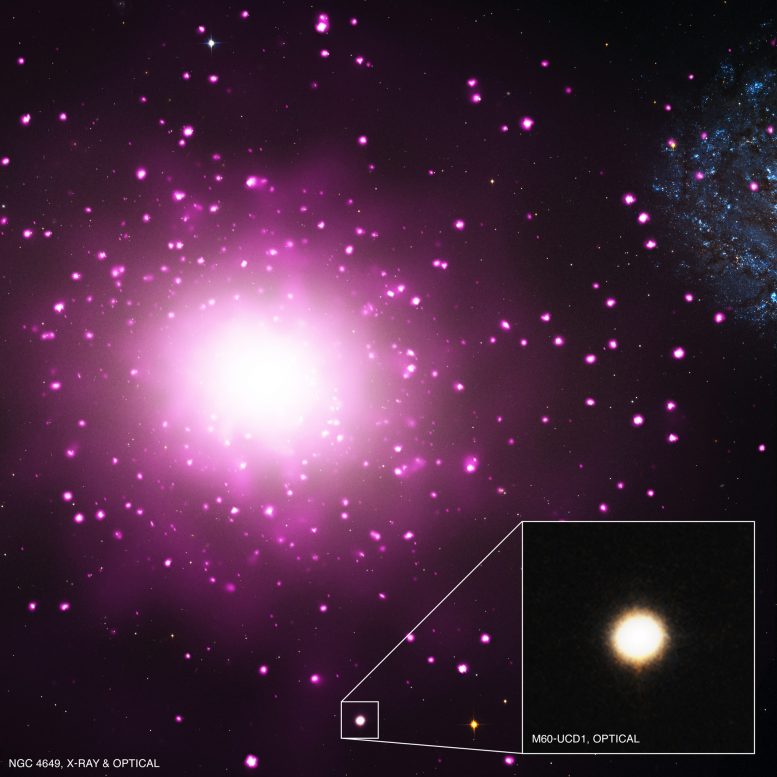
Using Chandra, Hubble, and ground-based telescopes, astronomers have discovered an ultra-compact dwarf galaxy that weighs more than 200 times our Sun, over half of which is concentrated within a radius of just 80 light years.
The densest galaxy in the nearby part of the Universe may have been found. Packed with an extraordinary number of stars, this unusual galaxy is providing astronomers with clues to its intriguing past and how it fits into the galactic evolutionary chain.
The galaxy, known as M60-UCD1, is a type of “ultra-compact dwarf galaxy”. It was discovered with NASA’s Hubble Space Telescope and follow-up observations were done with NASA’s Chandra X-ray Observatory and ground-based optical telescopes.
Observations from the W. M. Keck Observatory on the summit of Mauna Kea, Hawaii, characterized it as the most luminous known galaxy of its type and one of the most massive, weighing 200 million times more than our Sun.
What makes M60-UCD1 so remarkable is that about half of this mass is found within a radius of only about 80 light years. This would make the density of stars about 15,000 times greater than found in Earth’s neighborhood in the Milky Way, meaning that the stars are about 25 times closer.
“Traveling from one star to another would be a lot easier in M60-UCD1 than it is in our galaxy,” said Jay Strader of Michigan State University in Lansing, first author of a new paper describing these results. “But it would still take hundreds of years using present technology.”
The 6.5-meter Multiple Mirror Telescope in Arizona was used to study the amount of elements heavier than hydrogen and helium in stars in M60-UCD1. The values were found to be similar to our Sun.
“The abundance of heavy elements in this galaxy makes it a fertile environment for planets and, potentially, life to form,” said co-author Anil Seth of the University of Utah.
Another intriguing aspect of M60-UCD1 is that the Chandra data reveal the presence of a bright X-ray source in its center. One explanation for this source is a giant black hole weighing in at some 10 million times the mass of the Sun.
Astronomers are trying to determine if M60-UCD1 and other ultra-compact dwarf galaxies are either born as jam-packed star clusters or if they are galaxies that get smaller because they have stars ripped away from them. Large black holes are not found in star clusters, so if the X-ray source is in fact due to a massive black hole, it was likely produced by collisions between the galaxy and one or more nearby galaxies. The mass of the galaxy and the Sun-like abundances of elements also favor the idea that the galaxy is the remnant of a much larger galaxy.
“We think nearly all of the stars have been pulled away from the exterior of what once was a much bigger galaxy,” said co-author Duncan Forbes of Swinburne University in Australia. “This leaves behind just the very dense nucleus of the former galaxy, and an overly massive black hole.”
If this stripping did occur, then the galaxy was originally 50 to 200 times more massive than it is now, which would make the mass of its black hole relative to the original mass of the galaxy more like the Milky Way and many other galaxies. It is possible that this stripping took place long ago and that M60-UCD1 has been stalled at its current size for several billion years. The researchers estimate that M60-UCD1 is more than about 10 billion years old.
The density of stars in the galaxy is so high astronomers do not expect to find a signature of dark matter in the motion of stars. However, these galaxies are considered likely to contain some dark matter. If they do, they are important for making comparisons with computer simulations of the formation of galaxies, which typically predict a larger number of clumps of dark matter than observed.
M60-UCD1 is located near a massive elliptical galaxy NGC 4649, also called M60, about 60 million light-years from Earth. These results appear online and have been published in the September 20th issue of The Astrophysical Journal Letters.
NASA’s Marshall Space Flight Center in Huntsville, Alabama, manages the Chandra Program for NASA’s Science Mission Directorate in Washington. The Smithsonian Astrophysical Observatory controls Chandra’s science and flight operations from Cambridge, Massachusetts.
Reference: “The Densest Galaxy” by Jay Strader, Anil C. Seth, Duncan A. Forbes, Giuseppina Fabbiano, Aaron J. Romanowsky, Jean P. Brodie, Charlie Conroy, Nelson Caldwell, Vincenzo Pota, Christopher Usher and Jacob A. Arnold, 30 August 2013, The Astrophysical Journal Letters.
DOI: 10.1088/2041-8205/775/1/L6
arXiv:1307.7707
Never miss a breakthrough: Join the SciTechDaily newsletter.